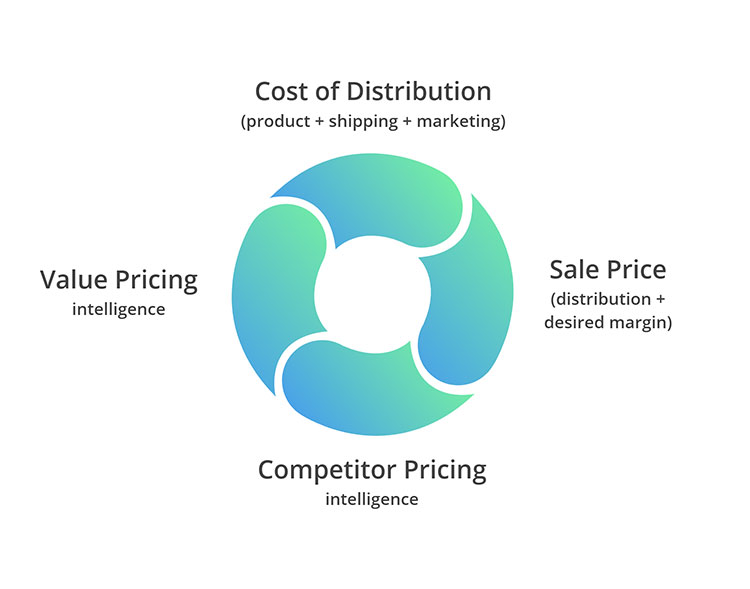28 Feb Do you want a new pricing model that can make you a healthy margin?
Why choose between three standard options when you could combine them all for one effective approach?
The current situation
Historically there are three commonly used pricing strategies you can employ when setting your prices in e-commerce. These include cost pricing, competitor pricing and value based pricing. All have their pros and cons, but in isolation the cons are often too significant. For the benefit of those who have not come across these, below is a brief outline of each strategy and the main problem they have.
Cost-based Pricing
You set your prices based on your total cost (product + shipping + marketing) and add your desired margin. The problem here is without the relevant pricing intelligence, you do not know if your purchase price is optimised. Also it is a mystery as to whether you are spending the right amount on marketing the product, or if you are even getting the best possible deal on shipping. Therefore the price you come up with may bare little relation to what customers are willing to pay or what your competition is pricing at.
Competitor-based Pricing
Your prices are based on competitor pricing. Often this can turn into a race to the bottom when other factors are not taken into account.
Value-based Pricing
You are setting a price based on the perceived value of the product you are selling to a particular segment. Here you are making estimations based on market research. The pricing may differ depending on the time of year (you’ll pay more for a winter coat when it’s cold). The downside of this approach is that it does not take into account cost and margin factors, nor does it allow you to look at competition and where your prices compare. A consumer may be willing to pay £100 for an item, but if it’s available for £85 they are likely to go for that when the perceived value offering is the same.
A new approach – The Competitive Value Model
Since the cons of each of these approaches are closely related to the pros of the others, the sensible approach is to combine them in such a way that combats the cons. The main downside to this new approach is that it will require more involvement from the business.
By using a combination of the three approaches you can build a pricing model which means that you. You can: make a healthy margin, be competitive (not necessarily the cheapest), and have prices that reflect the perceived value of your target market. The final point is very much dependant on you. For example, if you want to charge 10% more for your product over a competitor, you need to communicate the added value that your offering gives. That can be anything from the product itself or to the service you offer.
Make your margin
Profit is the ultimate aim for e-commerce, so it’s usually pretty important to use the cost aspect of pricing strategy.
- Set up rules based on your cost price, your distribution costs and your desired margin.
- At the same time monitor your competitors pricing to educate your purchasing department on what they should be aiming at with regards to optimising purchase prices.
- Finally, use your research from value-based pricing to feed into this process, so that it becomes circular and you are constantly optimising your costs based on market conditions.

Be Competitive
By monitoring your competitors’ pricing, you are empowering yourself with market intelligence. To combat the idea that monitoring their prices will lead to a “race to the bottom”, think about the times where you have the cheapest price and you can actually raise prices. Depending on the type of retailer you are, you may want to keep your prices above certain competitors. Finally, there may be situations where you want to be the cheapest. For instance, if you have excess stock you need to get rid of quickly, or if your suppliers are running a promotional deal which you can pass on to customers.
Be Valuable
As the diagram suggests, the perceived value of your product should always feed into your pricing strategy. If you combine this information with your competitor pricing and your knowledge of their value offering, you can ensure that once you have set a price, you have the correct value messaging to match. For example, John Lewis are rarely the cheapest retailer; in order to sell their products at a higher price, they offer superior service and longer product warranties. Lidl are often a cheap retailer, for them their value offering is giving shoppers access to the same or similar quality brands at a lower price through a streamlined distribution model. Sometimes value pricing is much simpler; for instance if your competitors are all out of stock and there is demand for the product, suddenly the value goes up and you can raise prices.
Tools to help
This pricing model relies on you having a sound understanding of your cost base associated with selling your product. Whilst this should be elementary, many companies can find this difficult. There are tools to help you with this, from accountancy software to help keep track of your P+L, to e-commerce platforms which help you sell online and analyse that data.
When it comes to monitoring competitor pricing and out of stock alerts, price monitoring software is becoming more and advanced and allows you to build market intelligence as well as give a direct comparison to your prices. It is an integral part of the pricing model we are advocating to combine all three aspects of pricing strategy.
The trickiest aspect of the model is determining perceived value. There are a number of excellent guides on this and you can even bring in consultants to help you. A particularly useful resource is from McKinsey & Company who have done a lot of work in the area.





